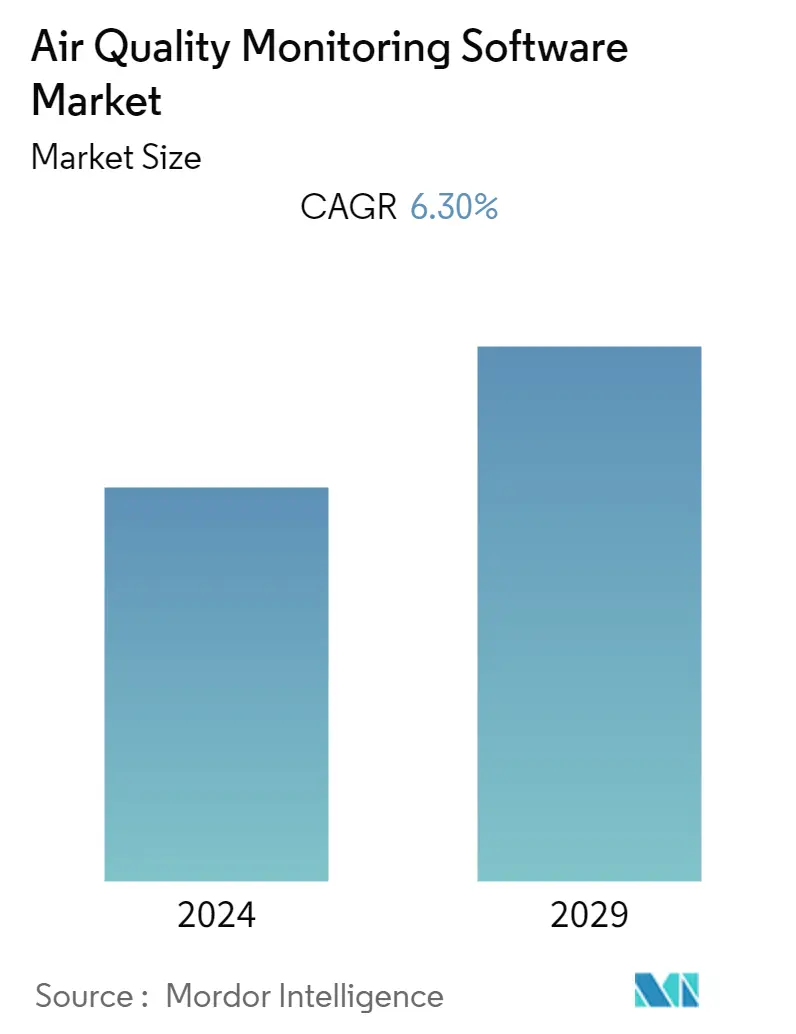Market Size of Air Quality Monitoring Software Industry

| Study Period | 2019 - 2029 |
| Base Year For Estimation | 2023 |
| Forecast Data Period | 2024 - 2029 |
| Historical Data Period | 2019 - 2022 |
| CAGR | 6.30 % |
| Fastest Growing Market | Asia-Pacific |
| Market Concentration | Low |
Major Players
*Disclaimer: Major Players sorted in no particular order |
Air Quality Monitoring Software Market Analysis
The Air Quality Monitoring Software Market is expected to grow at a CAGR of 6.3% for the next five years. More people are required to assess project needs and comprehend building projects' internal or external components.
- Over the forecast period, the market is expected to be driven by increasing government initiatives for developing environmentally friendly industries, growth in the industrial sector that is creating a demand for air quality monitoring software, and strict government regulations for efficient air pollution monitoring and control.
- The market for air quality monitoring software is primarily driven by the increasing installation and use of air quality monitoring systems in both developed and developing nations. Additionally, there is a need for more skilled professionals to monitor and control the software and regular R&D infrastructure to develop a cost-effective monitoring system for developing countries.
- However, one of the major challenges associated with air quality monitoring software is the high cost of installation and constant invigilating of the readings. There is also a need for skilled persons for pollution control and monitoring measures and more research and development infrastructure for expanding cost-effective air maintenance technology.
- As the relationship between air quality and health, well-being, creativity, and productivity becomes increasingly clear, indoor air quality (IAQ) is receiving more attention than ever. Most major groups and agencies worldwide rank poor IAQ as one of the top five health concerns. As a result, proper indoor air quality is becoming a bigger priority for organizations, governments, institutions of higher learning, building owners, and managers worldwide.
- One of the main causes of death worldwide is air pollution. In the major developing Asian countries, there are numerous air quality problems, yet during COVID-19 lockdowns, urban air quality improved because of the decrease in public movement and fuel consumption. As a result, fewer industries needed air quality assessment equipment. However, due to rising worries about air quality and the rise of industrialization in many nations, post the relaxation of the Covid-related guidelines, the market is projected to accelerate soon.
Air Quality Monitoring Software Industry Segmentation
Air quality monitoring software is an instrument that assists in making long-term strategic decisions regarding air quality. It is an information system that gives people the data for scientifically informed strategic planning and decision-making on air quality in a user-friendly environment in the form of an interactive map.
The Air Quality Monitoring Software Market is segmented by Type (Indoor AQMS and Outdoor AQMS), End-User (Residential and Commercial, Industrial and Public Agencies -Government, Research Institutes, and UAQMA), and Geography (North America, Europe, Asia Pacific, Latin America, and the Middle East and Africa). The market sizes and forecasts are provided in terms of value (USD million) for all the above segments.
| By Type | |
| Indoor Air Quality Monitoring Software | |
| Outdoor Air Quality Monitoring Software |
| By End User | |
| Residential and Commercial | |
| Industries | |
| Public Agencies (Government, Research Institutes, and UAQMA) |
| By Geography | |
| North America | |
| Europe | |
| Asia Pacific | |
| Latin America | |
| Middle East and Africa |
Air Quality Monitoring Software Market Size Summary
The Air Quality Monitoring Software Market is poised for significant growth, driven by increasing government initiatives aimed at fostering environmentally friendly industries and stringent regulations for air pollution control. The demand for air quality monitoring software is bolstered by the rising industrial sector, which necessitates effective air quality management systems. The market is characterized by the growing installation and utilization of these systems across both developed and developing nations. However, challenges such as the high cost of installation and the need for skilled professionals to oversee monitoring efforts persist. The emphasis on indoor air quality (IAQ) is gaining traction, with organizations and governments prioritizing it due to its impact on health and productivity. This shift is expected to propel the market forward, particularly in sectors like offices and medical labs, where maintaining air quality is crucial.
In Asia, the market is expected to capture the largest share due to alarming levels of air pollution driven by industrialization and urbanization. Major cities are grappling with high emissions from vehicles and industrial activities, prompting governments to implement stricter pollution control measures and promote smart city initiatives. The region's market growth is further supported by the commercialization of advanced monitoring technologies and the adoption of IoT systems, which offer reliable and efficient air quality measurements. Key players in the market, such as Siemens AG, Thermo Fisher Scientific, and Robert Bosch GmbH, are actively engaging in collaborations and technological advancements to strengthen their market positions. These efforts, coupled with strategic agreements and innovative solutions, are expected to enhance the capabilities of air quality monitoring software, driving its adoption across various sectors.
Air Quality Monitoring Software Market Size - Table of Contents
-
1. MARKET INSIGHTS
-
1.1 Market Overview
-
1.2 Industry Attractiveness-Porter's Five Forces Analysis
-
1.2.1 Bargaining Power of Suppliers
-
1.2.2 Bargaining Power of Consumers
-
1.2.3 Threat of New Entrants
-
1.2.4 Threat of Substitute Products
-
1.2.5 Intensity of Competitive Rivalry
-
-
1.3 Impact of COVID-19 on the Air Quality Monitoring Software Market
-
-
2. MARKET SEGMENTATION
-
2.1 By Type
-
2.1.1 Indoor Air Quality Monitoring Software
-
2.1.2 Outdoor Air Quality Monitoring Software
-
-
2.2 By End User
-
2.2.1 Residential and Commercial
-
2.2.2 Industries
-
2.2.3 Public Agencies (Government, Research Institutes, and UAQMA)
-
-
2.3 By Geography
-
2.3.1 North America
-
2.3.2 Europe
-
2.3.3 Asia Pacific
-
2.3.4 Latin America
-
2.3.5 Middle East and Africa
-
-
Air Quality Monitoring Software Market Size FAQs
What is the current Air Quality Monitoring Software Market size?
The Air Quality Monitoring Software Market is projected to register a CAGR of 6.30% during the forecast period (2024-2029)
Who are the key players in Air Quality Monitoring Software Market?
Thermo Fisher Scientific Inc., Siemens AG, Robert Bosch GmbH., Honeywell HBT and Aeroqual Ltd. are the major companies operating in the Air Quality Monitoring Software Market.

